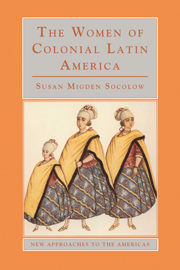Book contents
- Frontmatter
- Contents
- List of Illustrations
- Acknowledgments
- Introduction: Why Women?
- 1 Iberian Women in the Old World and the New
- 2 Before Columbus: Women in Indigenous America and Africa
- 3 Conquest and Colonization
- 4 The Arrival of Iberian Women
- 5 Women, Marriage, and Family
- 6 Elite Women
- 7 The Brides of Christ and Other Religious Women
- 8 Women and Work
- 9 Women and Slavery
- 10 Women and Social Deviance: Crime, Witchcraft, and Rebellion
- 11 Women and Enlightenment Reform
- Conclusion
- Documents
- Suggested Further Reading
- Index
- Plate section
5 - Women, Marriage, and Family
Published online by Cambridge University Press: 05 June 2012
- Frontmatter
- Contents
- List of Illustrations
- Acknowledgments
- Introduction: Why Women?
- 1 Iberian Women in the Old World and the New
- 2 Before Columbus: Women in Indigenous America and Africa
- 3 Conquest and Colonization
- 4 The Arrival of Iberian Women
- 5 Women, Marriage, and Family
- 6 Elite Women
- 7 The Brides of Christ and Other Religious Women
- 8 Women and Work
- 9 Women and Slavery
- 10 Women and Social Deviance: Crime, Witchcraft, and Rebellion
- 11 Women and Enlightenment Reform
- Conclusion
- Documents
- Suggested Further Reading
- Index
- Plate section
Summary
“Mother, what is marriage about?”
“My child, it is spinning, bearing children, and crying.”
The centrality of the family – the nuclear family and the extended kin group – to social organization was a Mediterranean cultural value that the Spanish and Portuguese transplanted to America. This importance of family meant that marriage, the institution that created new families, was viewed by church and state as crucial to an orderly social organization in the colonies. Furthermore, marriage protected females and delineated the boundary between those children who were legitimate (and therefore had legal claim against the family's property) and those who were not. Although throughout colonial Latin America, legitimate marriage coexisted with other more informal relationships, marriage and the legitimacy it bestowed were marks of status, the indication that one was a person of rank rather than a mere plebeian, a Spaniard rather than a mixed-blood.
As a result, in colonial Latin America marriage was closely tied to race, social status, and economic conditions. Indeed, legal marriage was only overwhelmingly practiced by two socioracial groups, groups that paradoxically occupied widely separated positions on the social scale. One group with a strong tendency to marry was the white elite (here we can include those who aspired to its ranks). The other group comprised Indians living in rural communities.
- Type
- Chapter
- Information
- The Women of Colonial Latin America , pp. 60 - 77Publisher: Cambridge University PressPrint publication year: 2000

